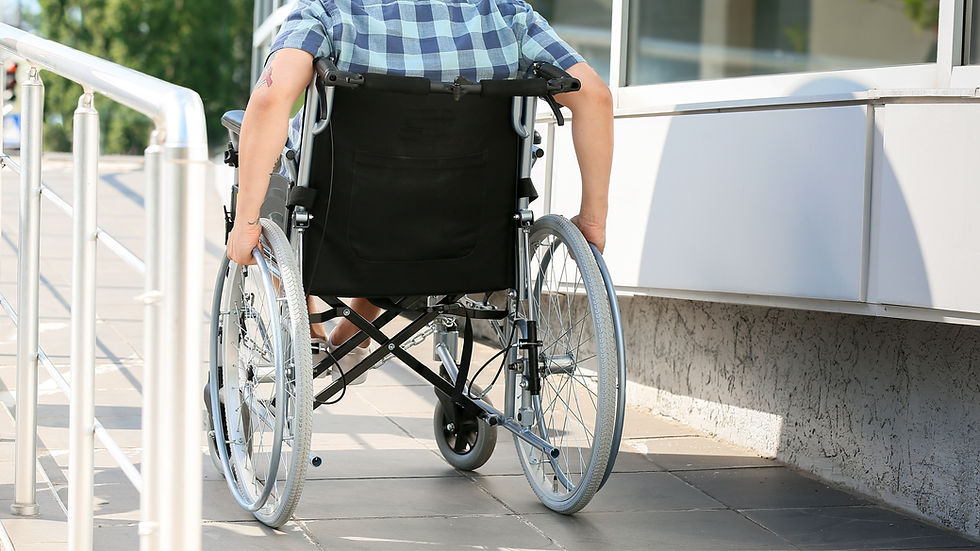ADA Compliance in Southwest Florida Commercial Remodels: Essential Guidelines for Business Owners
- Paul Maloney
- Aug 7
- 2 min read
Whether you're remodeling a retail space in Naples, upgrading an office in Sarasota, or rebuilding after storm damage in Punta Gorda, ADA compliance is a critical, and legally required, part of any commercial renovation.
The Americans with Disabilities Act (ADA) ensures that people of all abilities can access and navigate public spaces. For commercial remodels in Southwest Florida, this means your project must meet specific standards for entrances, restrooms, parking, signage, and more.
Here’s a breakdown of essential ADA guidelines, common pitfalls, and how to stay compliant while creating an inclusive and professional environment for your customers and employees.

What Is ADA Compliance in Construction?
Passed in 1990, the ADA requires that any new construction or significant remodels of public-facing or employee-used spaces meet guidelines that ensure equal access for individuals with disabilities.
Failure to comply can result in:
Costly lawsuits
Lost business from underserved populations
Delays in project permitting or final inspections
Key ADA Compliance Areas in Commercial Remodels
1. Accessible Entrances
At least one entrance must be wheelchair accessible
Slopes must not exceed 1:12 ratio (1 inch rise per 12 inches of length)
Automatic door openers or lever-style handles are required
Clear doorways: minimum 32 inches wide
2. Parking & Pathways
Designated ADA parking spaces with correct signage and access aisles
Safe, non-slip walkways leading to the entrance
Ramps must have handrails and landings
3. Restrooms
At least one accessible restroom with:
60-inch turning radius
Grab bars near the toilet
Accessible sinks with knee clearance
Lever or automatic faucets
4. Interior Circulation
Clear pathways of at least 36 inches wide
Elevators or lifts in multi-level buildings
Tables or counters with accessible sections (maximum 34-inch height)
5. Signage & Fixtures
ADA-compliant signage includes:
Raised lettering and Braille
High-contrast, easy-to-read fonts
Proper mounting height (typically 48–60 inches from the floor)

When Does a Remodel Trigger ADA Compliance?
Under the ADA, any alteration to a public space must include updates to bring the entire path of travel into compliance, if it is “readily achievable.” This includes:
Bathrooms
Entrances and doorways
Routes between spaces
Parking and drop-off zones
In Florida, local permitting offices (including those in Charlotte, Collier, and Sarasota counties) also enforce Florida Building Code - Accessibility standards, which are often stricter than federal guidelines.
How We Help at Maloney Homes
At Maloney Homes, we work closely with building inspectors and commercial clients to ensure your project:
Meets or exceeds ADA and Florida Building Code requirements
Is thoughtfully designed for comfort, safety, and inclusion
Stays on budget by addressing compliance early in the design phase
From restaurant renovations in Punta Gorda to retail build-outs in Naples, our team brings experience and attention to detail that protects your investment, and your customers.
Make Accessibility an Asset, Not an Afterthought
Beyond legal compliance, ADA-friendly design welcomes more customers, including seniors, veterans, and families with strollers. Accessible design isn’t just about checklists, it’s about community and care.
Ready to Remodel? Let’s Talk Accessibility.
Planning a commercial renovation in Southwest Florida? We’ll help you stay ADA-compliant while creating a space that looks beautiful, feels intuitive, and serves everyone.
📍 Serving Naples, Sarasota, Punta Gorda & surrounding areas
-2_MH%20Logo%20-%20Light%20(1).png)




